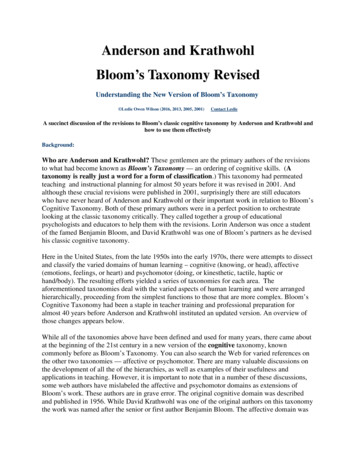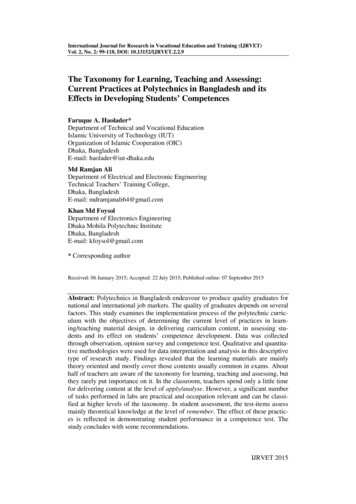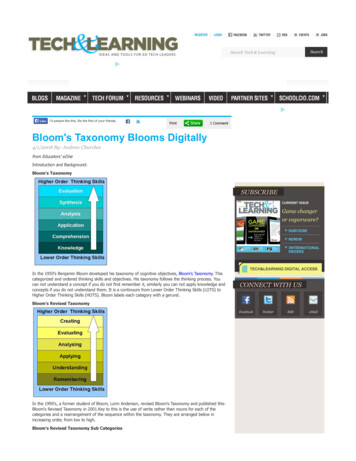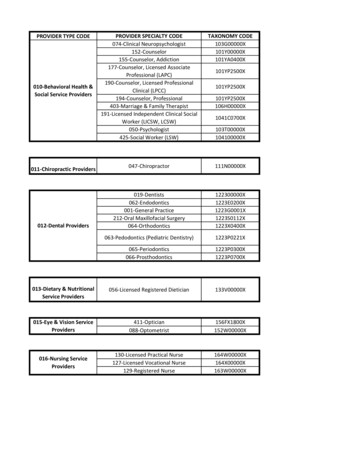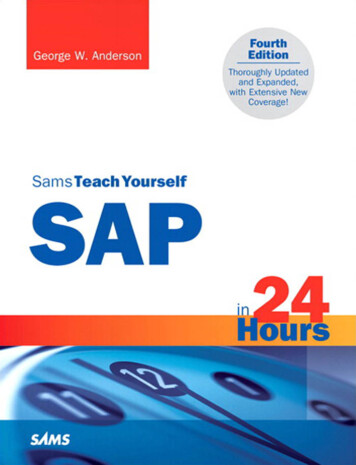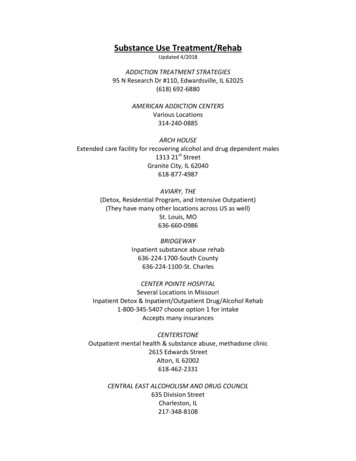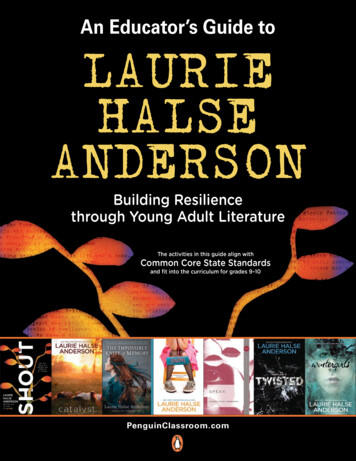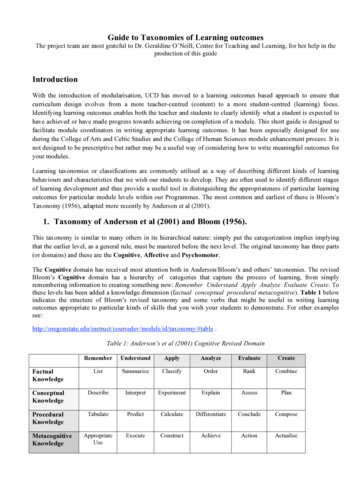
Transcription
Guide to Taxonomies of Learning outcomesThe project team are most grateful to Dr. Geraldine O’Neill, Centre for Teaching and Learning, for her help in theproduction of this guideIntroductionWith the introduction of modularisation, UCD has moved to a learning outcomes based approach to ensure thatcurriculum design evolves from a more teacher-centred (content) to a more student-centred (learning) focus.Identifying learning outcomes enables both the teacher and students to clearly identify what a student is expected tohave achieved or have made progress towards achieving on completion of a module. This short guide is designed tofacilitate module coordinators in writing appropriate learning outcomes. It has been especially designed for useduring the College of Arts and Celtic Studies and the College of Human Sciences module enhancement process. It isnot designed to be prescriptive but rather may be a useful way of considering how to write meaningful outcomes foryour modules.Learning taxonomies or classifications are commonly utilised as a way of describing different kinds of learningbehaviours and characteristics that we wish our students to develop. They are often used to identify different stagesof learning development and thus provide a useful tool in distinguishing the appropriateness of particular learningoutcomes for particular module levels within our Programmes. The most common and earliest of these is Bloom’sTaxonomy (1956), adapted more recently by Anderson et al (2001).1. Taxonomy of Anderson et al (2001) and Bloom (1956).This taxonomy is similar to many others in its hierarchical nature: simply put the categorization implies implyingthat the earlier level, as a general rule, must be mastered before the next level. The original taxonomy has three parts(or domains) and these are the Cognitive, Affective and Psychomotor.The Cognitive domain has received most attention both in Anderson/Bloom’s and others’ taxonomies. The revisedBloom’s Cognitive domain has a hierarchy of categories that capture the process of learning, from simplyremembering information to creating something new: Remember Understand Apply Analyze Evaluate Create. Tothese levels has been added a knowledge dimension (factual conceptual procedural metacognitive). Table 1 belowindicates the structure of Bloom’s revised taxonomy and some verbs that might be useful in writing learningoutcomes appropriate to particular kinds of skills that you wish your students to demonstrate. For other dev/models/id/taxonomy/#table .Table 1: Anderson’s et al (2001) Cognitive Revised veKnowledge
Krathwohl’s Taxonomy of the Affective Domain was developed from Bloom’s original and is the best known of theaffective domains, it includes concepts such as Receiving ideas; Responding to ideas, phenomena; Valuing ideas,materials; Organization of ideas, values; Characterisation by value set (or to act consistently in accordance withvalues internalised). The learner moves from being aware of what they are learning to a stage of havinginternalised the learning so that it plays a role in guiding their actions. We expect graduates of our colleges todevelop the ability to respond with a highly developed value system to the world around them and in expressing thiskind of outcome, we can use affective domain framework. The affective domain is certainly applicable in Arts andHuman Sciences, as it captures the idea of students learning the value of what is being taught. Educators can expectthat students learn to value and appreciate literature, music, visual art, culture etc as part of their learning aboutthem. It is normal for us to expect students to come to appreciate the significance of many of the ideas and topic weare teaching rather than just mastering skills. The affective domain is one area where we can find the vocabulary tohelp express this expectation. (see es2/krathstax.htm) (Seels& Glasgow, 1990).Table 2: Affective DomainLevelCharacteristicSome VerbsReceivingDeveloping awareness of ideas andphenomenaRespondingCommitting to the ideas etc by Answer Recite Performresponding to themFollow Explore DisplayValuingBeing willing to be seen as valuing Justify Propose Debate Relinquish Defendcertain ideas or materialInitiateOrganisationandConceptualisationTo begin to harmonise internalisedvaluesArrangeTheorizeCharacterisation byvalueTo act consistentinternalised valuesDiscriminate Question Revise ChangewiththeAsk Follow Reply Accept PreferCombineReport SelectCompareBalanceAn example of a useful Psychomotor domain is Dave’s (1970) and Ferris and Aziz’s (2005) adaptation of Bloom’soriginal Taxonomy. The key categories in this competence capture the development in learning from initialexposure to final, unconscious mastery. While the taxonomy deals largely with motor-area skills and the mastery ofthem, it is also applicable to the Colleges of Arts and Celtic Studies, and Human Sciences. Many of the skills andattributes we seek to impart to our students involve just this kind of development. This may be the more obviousones such as performing on a musical instrument or being part of a successful excavation, but included here are alsosuch things as the development of fluency in a language as well as the key transferable skills of encoding anddecoding information in graphic forms, such as tree diagrams and bar charts along with the abiloity to produceaccurate maps. The key stages and a brief explanation are shown below in table format. For another view on thecategorisation and organisation of the psychomotor domain, you can vist the w).Table 3 Psychomotor DomainLevelCharacteristicSome VerbsPerception / ObservingHere the student isobserving the proceduresimply Observe Listen DetectGuided Response / ImitationThestudentcanfollow Copy React Follow Reproduceinstructions but needs to beinstructed
MechanismThis is an intermediate stagewhere proficiency ad conficenceare growingOrganise ManipulateComplex responseProficiency has grown andperformance is quick andaccurate with little or nohesitationThe verbs are essentially the same asMechanism,butmodifiedby‘accurately’ or ‘quickly’AdaptationThe student has such ability that Reorganisethey can combine and integrate Internaliserelated aspects of the skillwithout guidanceOriginationThe student has internalisedautomatic mastery of the skillAlterRearrange VaryCompose Construct Design InitiateCreate2. The SOLO (Structure of Observed Learning Outcomes)TaxonomyThe alternative to Blooms’ Cognitive Domain that is commonly utilised in Higher Education is the SOLOTaxonomy. It has been used to not only assist in writing learning outcomes but has also been used tocategorise answers and is often used in assessment criteria. There are five hierarchical levels (Biggs &Collis, 18982; Biggs, 1992) that range from incompetence to expertise (Boulton-Lewis, 1994). A goodrepresentation of the SOLO taxonomy and the different types of relations it deals with can be found lo.htm.Table 4: SOLO TaxonomyLevelCharacteristicSome verbsPre-StructuralIncompetent, nothing known about the area-Uni-StructuralOne relevant aspect is knownMulti-structuralSeveral relevant independent aspects areknownDescribe Classify CombineRelationalAspects of knowledge are integrated into astructureAnalyse, Explain, IntegrateExtended AbstractKnowledge is generalised into a new domainList, Name MemorizePredict, Reflect, Theorise3. Finks Taxonomy.Unlike the previous two taxonomies, Fink (2003) presents a taxonomy that is not hierarchical. In addition it covers abroader cross section of domains with the exception of a psychomotor domain. It is similar to Anderson’s taxonomy(2001) in its emphasis is on metacognition (learning to learn) and also includes more affective aspects such as the‘human dimension’ and ‘caring: identifying/changing one’s feelings’. Table 5 highlights some appropriate verbslinked to particular learning behaviours that may be of use in writing your learning outcomes. For more informationon Fink’s taxonomy see: http://www.ou.edu/pii/significant/WHAT%20IS.pdf
Figure 1: Finks Taxonomy (2003)Table 5: Finks Taxonomy (2003; 2009)DimensionDescriptionSome VerbsFoundational KnowledgeUnderstand and rememberApplicationCritical, creative and practical thinkling; Analyse interpret applyproblem solvingIntegrationMake connections among ideas, subjects, Describe integratepeopleHuman DimensionsLearning about and changing one’s self; Reflect assessunderstanding and interacting with othersCaringIdentifying/changinginterests, values.Learning to learnLearning how to ask and answer questions, Critique analyzebecoming a self-directed learnerone’sname list describefeelings,Reflect interpret,
Appendix 1: Overview of development of Taxonomies and their domainsCognitive1950sAffectiveBlooms et al (1956)CognitiveBlooms et al (1956)(1964) Affective1960sKrathwohl’s et al (1964)Affective1970sPsychomotorBloom (1956) Dave (1967/70) ;Simpson (1966/72); Harrow(1972) PsychomotorDave (1970)PsychomotorBiggs & Collis (1982)1980sSOLO Taxonomy(Cognitive)1990s2000-10Anderson et al (2001)Cognitive with KnowledgedimensionFink (2003)Foundational knowledge; Caring; Learning aboutoneself;Learning How to learn;Application.Integration;Appendix 2:Some critical thoughts when exploring the taxonomies. There has been some criticism in the literature of the practice and/or implications that all learningis simply hierarchical as it can imply that early years in the curriculum should only have lowercognitive level learning outcomes and experiences, i.e. factual, descriptive experiences.Challenging critical and complex learning activities can also be appropriate early in thecurriculum. The frameworks are a guide for developing a range of student learning experiences and not aprescription; they need to be contextualised for the different disciplines/subject areas. There has been, over the last 50 years, huge popularity in the use of the Cognitive domain, despitethe availability of the Affective and Psychomotor domains. These two have become more popularin recent years, despite the fact that all three have been there since 1956 (Bloom) Module co-ordinators may find the diagram in the SOLO taxonomy a useful help inunderstanding this version of the cognitive domain (see Biggs 1999b article in references andavailable in UCD’s Academic Search Premier Database). Don’t be put off by some of the educational language that may not seem to relate to your area, i.e.‘caring’ in the Finks Taxonomy, or ‘Psychomotor’ in Blooms. When you explore these conceptsfurther they relate to most areas/subjects/disciplines and can often reflect some coresubject/discipline values not easily covered when only using the cognitive domain.
References:Atherton, J. S. (2005) Learning and Teaching: SOLO taxonomy [On-line] UK: ning/solo.htm Accessed: 17 February 2009Biggs, J. (1999a) Teaching for Quality Learning at University: What the Student Does, Buckingham: The Societyfor Research into Higher Education and Open University Press.Biggs, J. (1999b) What the Student Does: teaching for enhanced learning. Higher Education Research &Development,18 (1) 57—75 (available in UCD through Academic Search Premier database)Biggs, J. B. and Collis, K. (1982) Evaluating the Quality of Learning: the SOLO taxonomy. New York, AcademicPressBloom, B. (ed.) (1956) Taxonomy of Educational Objectives, the classification of educational goals – Handbook I:Cognitive Domain New York: McKayDave, R. H. (1970) "Psychomotor Levels." In Developing and Writing Behavioral Objectives, ed. Robert J.Armstrong. Tucson AZ: Educational Innovators Press.Fink, L. D. (2003) Creating significant learning experiences: An integrated approach to designing college courses.San Francisco: Jossey-Bass.Fink, D.L, (2009) A self directed guide to designing course for significant learning. Access 21st Feb 1.pdfKrathwohl, D.R., Bloom, B.S., and Masia, B.B. (1964) Taxonomy of educational objectives: Handbook II: Affectivedomain. New York: David McKay Co.Romiszowski, A (1999) The Development of Physical Skills: Instruction in the Psychomotor Domain, Chapter 19,Instructional Design Theories and Models: A New Paradigm of Instructional Theory, Volume II, C. M. Reigeluth,Mahwah, NJ,; Lawrence Erlbaum Associates.Seels and Glasgow (1990) Exercises in instructional design. Columbus OH: Merrill Publishing Company.Simpson, E. (1972) The classification of educational objectives in the psychomotor domain: The psychomotordomain. Vol. 3. Washington, DC: Gryphon House.Businessballs.com (2009) Blooms Taxonomy-Learning oflearningdomains.htmAndersons et al (2001) new cognitive domain: d/taxonomy/#tableBased upon R. H. Dave, as reported in R. J. Armstrong et al., Developing and Writing Behavioural Objectives(Tucson, AZ: Educational Innovators Press, 1970)
of learning development and thus provide a useful tool in distinguishing the appropriateness of particular learning outcomes for particular module levels within our Programmes. The most common and earliest of these is Bloom’s Taxonomy (1956), adapted more recently by Anderson et al (2001). 1. Tax
